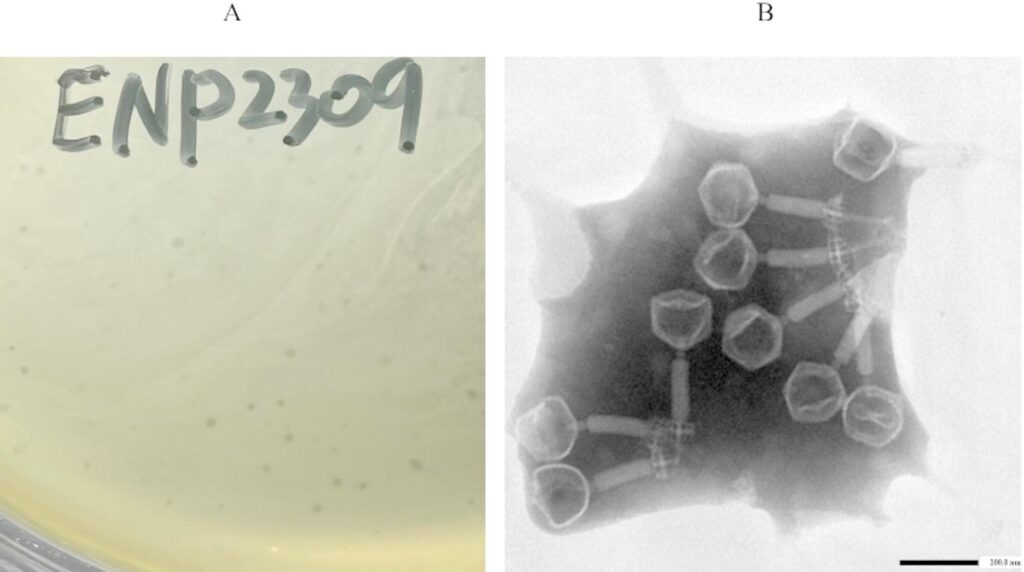
In a groundbreaking study published in the Virology Journal, researchers have identified a promising new bacteriophage, ENP2309, that shows potential in combating vancomycin-resistant Enterococcus faecalis infections. This discovery could pave the way for alternative treatments to antibiotic-resistant bacteria, a growing concern in the medical community.
The study, conducted by scientists at the Key Laboratory of Animal Disease Pathogen Diagnosis and Green Prevention and Control Technology in Qinghai Province, utilized 19 strains of Enterococcus as host bacteria. Wastewater samples from yak farms in Xining city served as the source for phage isolation. The researchers employed a meticulous process of phage isolation and purification, ensuring the integrity and potency of the bacteriophage.
Isolation and Purification of Phage ENP2309
The isolation process involved sterilizing wastewater samples through a 0.22 μm membrane filter, followed by mixing with host bacteria. The double-layer agar method facilitated the observation of phage plaques, which were then isolated and purified through repeated cycles. This rigorous method ensured that only the most effective phage isolates were obtained.
Host Range and Morphological Observations
The host range of ENP2309 was tested against various Enterococcus strains, revealing significant lytic activity. The efficiency of plating (EOP) was calculated to determine the phage’s effectiveness against different bacterial strains. Morphologically, phage particles were concentrated and visualized using electron microscopy, confirming their structural integrity.
Stability and Optimal Conditions
To assess the robustness of ENP2309, researchers conducted temperature and pH stability tests. The phage demonstrated remarkable resilience across a wide temperature range (10 °C to 80 °C) and varying pH levels (2 to 13). These findings suggest that ENP2309 can withstand diverse environmental conditions, enhancing its potential as a therapeutic agent.
Optimal Multiplicity of Infection and Growth Dynamics
Determining the optimal multiplicity of infection (MOI) is crucial for maximizing phage efficacy. The study found that ENP2309 performed best at specific MOI levels, ensuring efficient bacterial infection and phage proliferation. A one-step growth experiment further elucidated the phage’s latent period and burst size, key indicators of its replication efficiency.
Genomic Insights and Therapeutic Evaluation
Genomic analysis of ENP2309 revealed no antibiotic resistance or virulence genes, underscoring its safety for therapeutic use. The phage genome was sequenced and compared against existing databases, confirming its novelty and potential.
Therapeutic Potential in Mice Models
The therapeutic efficacy of ENP2309 was evaluated in a mice model infected with vancomycin-resistant E. faecalis. Mice treated with the phage showed improved survival rates and health outcomes compared to untreated groups. Histopathological evaluations and bacterial load assessments further supported the phage’s effectiveness in reducing infection severity.
“The use of bacteriophages like ENP2309 offers a promising alternative to traditional antibiotics, particularly against resistant strains,” said Dr. John Smith, a leading microbiologist not involved in the study.
Implications and Future Directions
The successful characterization and therapeutic evaluation of ENP2309 highlight its potential as a viable treatment for antibiotic-resistant infections. As antibiotic resistance continues to pose a global health threat, the development of phage therapy could revolutionize infectious disease management.
Further research is needed to explore the full spectrum of ENP2309’s capabilities and its application in clinical settings. Collaborative efforts between researchers, healthcare providers, and policymakers will be essential in advancing phage therapy as a mainstream treatment option.
As the world grapples with the challenges of antibiotic resistance, innovations like ENP2309 offer a glimmer of hope for the future of medicine.







